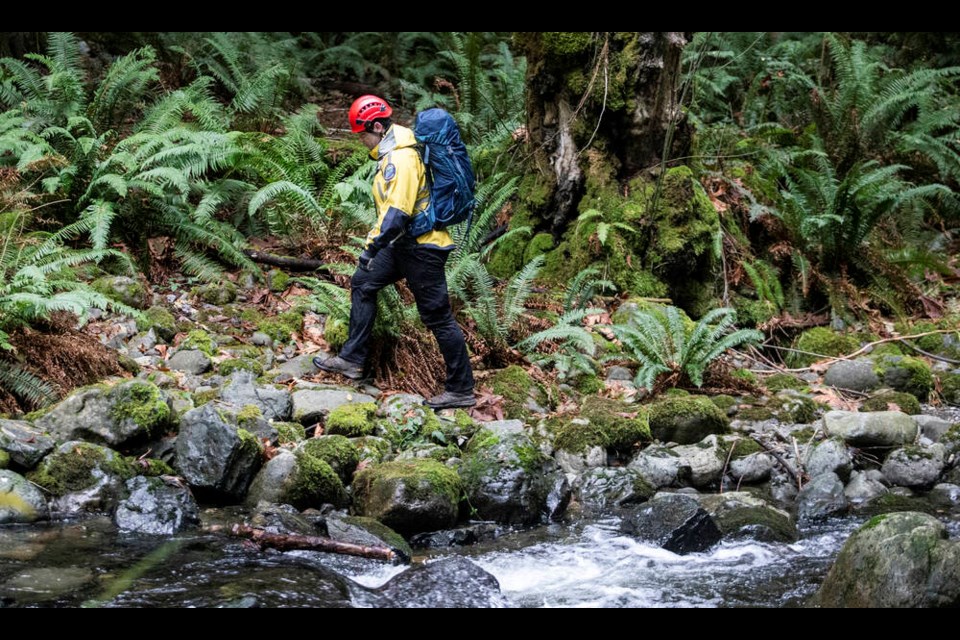The search for a Victoria woman last seen leaving the parking lot of the Charters Creek fish hatchery in Sooke with hiking poles was suspended on Monday, after an exhaustive search by search and rescue agencies from across the province found no trace of the 38-year old.
On Saturday alone, nearly 200 people logged close to 1,700 hours, working in extremely thick vegetation, to try to locate Melissa McDevitt, who was spotted on surveillance video Dec. 9, the day before she was scheduled to fly to see her family in North Carolina.
“The Sooke RCMP, along with Ms. McDevitt’s family, wish to extend their sincere appreciation to Juan de Fuca Search and Rescue, along with over 17 other assisting Search and Rescue agencies from across Vancouver Island and other parts of British Columbia, for their significant search efforts over the last nine days,” said Kevin Shaw, acting Sooke RCMP detachment commander sergeant, in a statement issued just after noon on Monday.
Search and Rescue teams from Vancouver Island were joined by personnel from other parts of the province — including dog teams — who showed up over the weekend to assist in the search.
While searches of up to 10 days are not uncommon, the search for McDevitt has been one of the largest undertaken in the last decade by volunteers, who spent upwards of 5,000 hours looking for her, said Paul Berry, president of Comox Valley Search and Rescue.
Sooke RCMP will maintain an open missing-person file should any new information come to light, and missing-person posters will be placed at trailheads in the area to remind people to be on the lookout for McDevitt, who is described as five feet tall and weighing about 105 pounds.
Security footage captured McDevitt as she left the parking lot of the Charters Creek fish hatchery, after parking her grey Subaru Forester there on Dec. 9.
A possible scenario is that the avid hiker got caught in the powerful windstorm that swept Vancouver Island the day of her disappearance, Berry said.
“She may have got caught in the storm and sought refuge, wrapping herself in vegetation to keep warm,” said Berry. “The vegetation in the area is so thick that searchers walking three metres apart, wearing high-visibility clothing, are unable to see each other.”
He said that the area where McDevitt disappeared, a few minutes from Sooke Potholes along the Sooke River Road, looks open at first, but quickly becomes dense bush.
The search for McDevitt is one of 74 Comox Valley Search and Rescue has undertaken in the last year.
Berry advises people heading outdoors to leave a trip plan — informing someone where they are going and when they expect to return home. “The sooner someone sounds the alarm, the sooner we can start to look for them,” he said.
Most of those who encounter mishaps or get lost can call for help using their cellphones if they are in range, but help can take time, which means wilderness users need to be prepared, he said.
“Most people forget that the further out they are, the longer it takes to respond — sometimes hours, so water, waterproof clothing and high-energy food is also important,” said Berry.
“They also neglect to have enough back-up power. Time and time again, we get a call at the end of a day. The people are lost and their phones only have two or three per cent of their power left.”
While it is possible to “ping” a phone to get its location, it doesn’t work if the phone is dead.
A headlamp is also handy, both to help you find your way in the dark, and as a signal for rescuers, Berry said.
While a phone’s GPS can show where someone is, without cellular service, they can’t summon help should they get in trouble.
Some outdoors enthusiasts now carry satellite communicators that operate in areas without cell reception. Some can pair with a cellphone to send texts or emails to pre-determined contacts in case of an emergency — or to let them know you are safe.
A subscription to satellite services is necessary, although some are free for a trial period.
The new Apple iPhone 14, which debuted in November, offers emergency SOS via a satellite connection as well. While Apple is the first to offer the technology, it is expected other phone manufacturers will jump in to include the feature in future models to stay competitive.
“These are amazing tools, with the new ones not just for SOS,” said Berry. “They can mean the difference between life or death.”
He also urges people to check out Adventuresmart.ca, a national program dedicated to encouraging people to get informed before they go outdoors. The goal of the program is to try and reduce the number and severity of search and rescue incidents through education.



